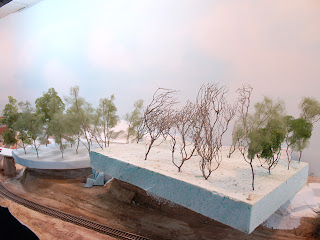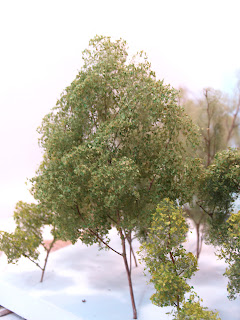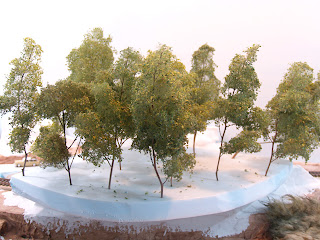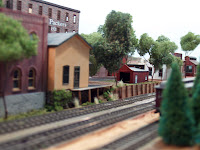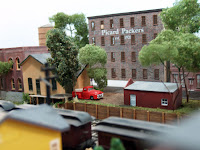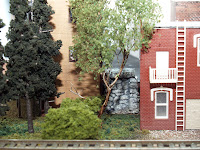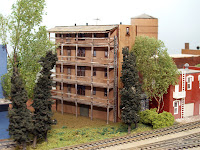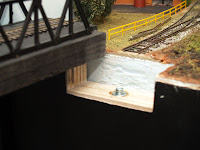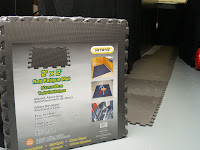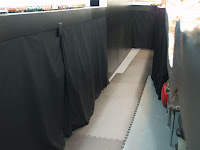I bought a couple of these locomotives about a year ago from our local model railroad supplier. I needed some extra power on the BS&T and because they were real cheap (<$40). I figured I couldn’t go wrong at that price!
Well, they ran “ok”, but had poor slow speed performance and hummed very loudly. You know the decoder hum you get from some cheap decoders? What did I expect for $40?
A couple months ago I bought a few NCE D13SR decoders for various locos I had without decoders. I planned to try them in these locos to see if it would make much difference. Well, I finally got around to that last week – while Kim was off to the states taking advantage of the high Canadian Dollar.
When I removed the fuel tank covering the body mount screws I was surprised to see a mess of capacitors and resistors attached to  the motor contacts. A capacitor was attached to each motor contact and then back to the metal casing around the motor. Another capacitor was attached across the motor contacts. The resistors were attached between the power wire and the motor contact. The picture shows the underside after cutting off the capacitors.
the motor contacts. A capacitor was attached to each motor contact and then back to the metal casing around the motor. Another capacitor was attached across the motor contacts. The resistors were attached between the power wire and the motor contact. The picture shows the underside after cutting off the capacitors.
I wondered if these might be causing the noise and performance problem. I figured the resistors were okay, just holding back some power to the motor, but I cut off all the capacitors, being careful not to cut the power lead. There was no difference when I ran the loco. So I went on to decoder installation.
After removing the body I saw that the decoder was a long one and that the LED’s were soldered directly to the board. I would have to figure out some way to mount the LED’s after I installed the D13SR decoder. As I was pondering that I noticed the decoder was screwed to the frame at each end just behind the LED’s. Then I thought that since this decoder was crap anyway why bother trying to save it? So, I used my razor saw to cut the decoder just behind each LED and screw. The old circuit board became the LED mount.
Next I unsoldered the wires from the now dead decoder. Double sided tape held the new decoder securely on the frame. I positioned it so that the wired end was roughly centered in the loco. I figured I could use the existing wires to do the whole install, including wiring the LED’s.
Bachmann used orange and purple wires to the motor (the standard is orange and grey). I figured I’d use the purple wire for grey and see how it worked out. I unsoldered the orange and grey wires from the decoder and soldered the motor leads in their place.
I trimmed the red and black wires to reach the nearest pickup leads and used the bit I trimmed off to run back to the other pickup leads. I made sure I put the shrink tubing on before I soldered everything together.
I trimmed the blue wire so that the 1000 Ohm resistor (as per the decoder’s instructions for use with LED’s) would reach to the nearest LED. The length of blue wire I trimmed off almost reached the other LED so I had to scrounge for another wire to run from one LED to the other.
I wasn’t sure which lead of the LED was the anode or cathode side so I had to wing it. I soldered the resistor to one side of the nearest LED and joined this to the same side of the other LED. Then I soldered the yellow wire to the other lead of the rear LED and the white wire to the other lead of the front LED.

This is the loco with the D13SR installed.
Then came the moment of truth. You should always test a new install by putting the loco on the programming track and attempt to read a CV. If that works without an error then you have no shorts. Once I knew the decoder was installed properly I put the loco on the main line and checked operation.
Wow! There wasn’t a sound as the loco moved down the track! But I had the leads on the LED’s reversed so the lights didn’t work. Back to the bench to switch the leads and back to the main line. The lights worked and the engine ran like a top.
The second loco took half the time and I didn’t mess up the LED’s. It also had a bit of a motor growl, but neither had the same power hum that they had before.
Brian called then with a computer problem that I was going over to help him with. I mentioned the locos and he asked me to bring one over so he could see it run. He was totally amazed at the difference. He had an Athearn CN GP35 shell that we determined would fit on the Bachmann frame with a little modification. So, off to Menzells’ to pick up another of the CP units he had so Brian could install a D13SR into and fit his CN shell on. I’ll get pictures of his unit when we operate there in a couple weeks.
 I decided that they ran so well they were worthy of being weathered. Here they are waiting to go to the service tracks in Tidewater during a recent operating session on the BS&T. Two very nice running locos with new decoders for about $50 each.
I decided that they ran so well they were worthy of being weathered. Here they are waiting to go to the service tracks in Tidewater during a recent operating session on the BS&T. Two very nice running locos with new decoders for about $50 each.
Later!
Scott















